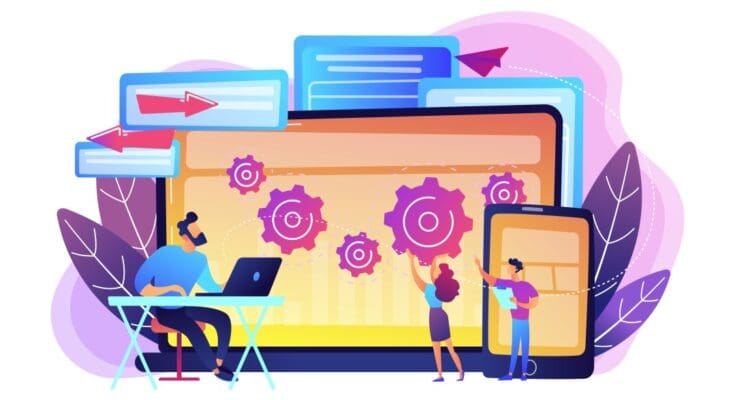Cross-Platform Development: Unifying Experiences
In the consistently advancing scene of application improvement, the interest for making applications that work flawlessly across various stages has become principal. Cross-stage advancement systems, like Shudder and Respond Local, have arisen as useful assets to address this need. This article dives into the ascent of cross-stage improvement and investigates what structures like Shudder and Respond Local mean for advancement speed and client experience.
Sorting out Cross-Stage Advancement:
The concept of cross-platform development has emerged as a game-changer in the dynamic field of application development. It includes making applications that can consistently run on different working frameworks, dispensing with the requirement for various codebases for various stages. Customarily, engineers needed to explore the intricacies of building particular adaptations of an application for every stage (iOS, Android, and so on.), resulting in longer development times, increased allocation of resources, and possible platform inconsistencies. Cross-stage improvement expects to work on this cycle, offering a brought together methodology.
The Ascent of Vacillate:
Ripple, a brainchild of Google, stands apart as a vigorous open-source UI programming improvement tool compartment. It engages engineers to create locally incorporated applications for versatile, web, and work area – all from a solitary, shared codebase. Using the Dart programming language and including a flexible arrangement of adaptable gadgets, Shudder empowers the production of a predictable and expressive UI across different stages. Its prominence has taken off, driven by imaginative elements, for example, hot reload, working with ongoing code changes and fast cycles.
The dominance of React Native:
In the serious scene of cross-stage structures, Respond Local, spearheaded by Facebook, has attested its predominance. Utilizing the broadly embraced Respond JavaScript library, Respond Local enables designers to fabricate versatile applications utilizing a recognizable language. The system’s measured design, pre-fabricated parts, and a broad environment of libraries add to sped up advancement cycles. Embracing a “advance once, compose anyplace” reasoning, Respond Local underscores the reuse of code across stages, a rule that reverberates with designers around the world.
Influence on Improvement Speed:
Accelerating the development process is one of the primary benefits offered by cross-platform development frameworks. Shudder and Respond Local empower designers to compose code once and convey it across various stages. This altogether decreases improvement time, smoothing out cycles, for example, refreshes, bug fixes, and the combination of new elements. The capacity to keep a particular codebase upgrades proficiency and responsiveness inside the improvement work process.

Improving Client Experience:
The essence of any fruitful application lies in conveying a steady and brilliant client experience. This is where Flutter and React Native shine, with user interfaces and performance that are comparable to those of native apps. Vacillate’s solidarity lies in its adjustable gadgets, while Respond Local’s scaffold to local parts guarantees a firm client experience. No matter what the gadget or stage, clients get a point of interaction that feels local, adding to a general good impression.
Challenges and Considerations:
Despite the clear advantages of cross-platform development, it’s essential to acknowledge potential challenges. Some applications may demand platform-specific features that pose difficulties in a cross-platform environment. Additionally, performance considerations need careful attention, especially for applications with intense graphics requirements. Balancing the desire for cross-platform compatibility with the need for specialized features and optimal performance requires thoughtful consideration.
Conclusion:
All in all, cross-stage improvement systems like Ripple and Respond Local have introduced another time, offering a bound together and proficient way to deal with application advancement. Adjusting improvement speed and client experience, these structures enable designers to contact more extensive crowds. These frameworks are likely to play a crucial role in determining the future of cross-platform application development as technology develops.
The Rise of Flutter:
Flutter, created by Google, is like a super tool for building different types of apps – be it for your phone, the web, or your computer. It’s open-source, meaning that anyone can use it and even improve it. What’s cool is that with Flutter, developers only need to write code once, and it magically works on mobile, web, and desktop. It talks in a language called Dart, making the user interface (UI) look awesome and consistent on all devices. One special feature called “Hot Reload” lets developers instantly see the changes they make in the code, making it super easy and fast to create and improve apps. That’s why Flutter has become so popular!
The Power of React Native:
React Native, developed by Facebook, stands out as a widely embraced cross-platform framework. Leveraging the popular React JavaScript library, React Native enables developers to build mobile applications using a familiar language. Its modular architecture, pre-built components, and a vast ecosystem of libraries contribute to faster development cycles. The “write once, run anywhere” philosophy of React Native emphasizes code reuse across different platforms.
Influence on Improvement Speed:
One of the huge benefits of cross-stage improvement is the speed increase of the advancement interaction. With Shudder and Respond Local, engineers can compose code once and send it across numerous stages, diminishing advancement time altogether. The capacity to keep a solitary codebase smoothes out refreshes, bug fixes, and element increments, encouraging a more effective improvement work process.
Improving Client Experience:
Making a predictable and brilliant client experience is a pivotal part of application improvement. Both Ripple and Respond Local succeed in giving local like execution and UIs. With Flutter’s customizable widgets and React Native’s bridge to native components, the end user will have a consistent experience no matter what platform or device they use.
Difficulties and Contemplations:
While cross-stage advancement offers various benefits, recognizing potential challenges is fundamental. A few applications might require stage explicit highlights that are not promptly accessible in cross-stage structures. Performance issues may also arise, particularly in graphics-intensive applications.
Conclusion:
Cross-stage improvement systems like Ripple and Respond Local have reclassified the scene of application advancement by offering a brought together methodology across stages. The harmony between improvement speed and client experience makes them integral assets for engineers planning to contact an expansive crowd. As innovation keeps on propelling, these systems will probably assume an essential part in molding the eventual fate of cross-stage application improvement.




